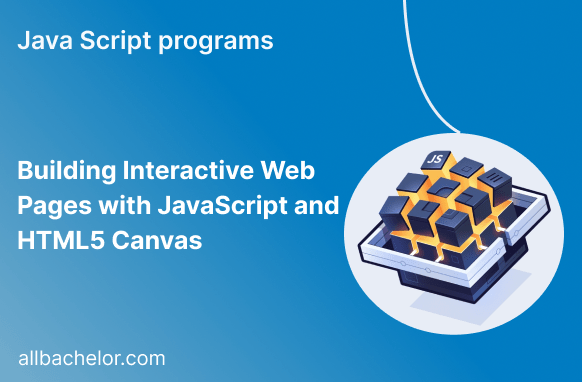Introduction:
In today’s internet era, making websites that engage visitors is essential. One exciting way to do this is by combining JavaScript and HTML5 Canvas. With HTML5 Canvas, developers can create interactive graphics, animations, and particle systems right in the browser. In this blog, we’ll learn how to use JavaScript and HTML5 Canvas together to build fun and interactive web pages, making your web projects more exciting and engaging for users.
What is HTML5 Canvas?
HTML5 Canvas is like a blank canvas on a web page where you can draw all sorts of things using JavaScript. It’s different from regular HTML elements because it doesn’t have anything already inside it. Instead, you can use JavaScript to create and display graphics, shapes, and images on this canvas. This makes it really great for making interactive and visually appealing elements on your website.
Getting Started:
To begin building interactive web pages with JavaScript and HTML5 Canvas, you need a basic understanding of HTML, CSS, and JavaScript. Let’s set up a simple HTML structure:
<!DOCTYPE html>
<html lang="en">
<head>
<meta charset="UTF-8">
<meta name="viewport" content="width=device-width, initial-scale=1.0">
<title>Interactive Canvas</title>
<style>
/* Add your custom styles here */
</style>
</head>
<body>
<canvas id="myCanvas"></canvas>
<script src="script.js"></script>
</body>
</html>In the above HTML, we’ve included a <canvas> element with the ID “myCanvas.” This is where the graphics will be drawn using JavaScript.
The JavaScript Part:
Now, let’s create the JavaScript file (script.js) that will handle the canvas drawing and interaction:
// Get the canvas element and its 2D context
const canvas = document.getElementById('myCanvas');
const ctx = canvas.getContext('2d');
// Set the canvas width and height
canvas.width = window.innerWidth;
canvas.height = window.innerHeight;
// Your drawing code here
// For example, let's draw a simple rectangle
// Set the initial position of the rectangle
let rectX = 50;
let rectY = 50;
const rectWidth = 100;
const rectHeight = 75;
function drawRect() {
// Clear the canvas on each frame
ctx.clearRect(0, 0, canvas.width, canvas.height);
// Draw the rectangle
ctx.fillStyle = 'blue';
ctx.fillRect(rectX, rectY, rectWidth, rectHeight);
}
// Function to update the position of the rectangle on user interaction
function updatePosition(event) {
rectX = event.clientX - rectWidth / 2;
rectY = event.clientY - rectHeight / 2;
}
// Add event listener to the canvas for mouse movement
canvas.addEventListener('mousemove', updatePosition);
// Animation loop to continuously update the canvas
function animate() {
drawRect();
requestAnimationFrame(animate);
}
// Start the animation loop
animate();Interactivity:
In this example, we have made the rectangle interactive using mouse movement. The rectangle follows the cursor as you move it over the canvas. Additionally, we can add interactivity through click events:
// Add event listener to the canvas for mouse click
canvas.addEventListener('click', changeColor);
function changeColor(event) {
// Check if the mouse click is within the rectangle
if (event.clientX >= rectX && event.clientX <= rectX + rectWidth &&
event.clientY >= rectY && event.clientY <= rectY + rectHeight) {
// Change the rectangle's color randomly
ctx.fillStyle = `rgb(${Math.random() * 255}, ${Math.random() * 255}, ${Math.random() * 255})`;
}
}Animations:
We can create smooth animations using the requestAnimationFrame method. For example, let’s make the rectangle bounce around the canvas:
// Define initial velocities
let rectVX = 2;
let rectVY = 2;
function animateBouncingRect() {
// Clear the canvas on each frame
ctx.clearRect(0, 0, canvas.width, canvas.height);
// Update the rectangle's position
rectX += rectVX;
rectY += rectVY;
// Bounce the rectangle off the edges of the canvas
if (rectX <= 0 || rectX + rectWidth >= canvas.width) {
rectVX *= -1;
}
if (rectY <= 0 || rectY + rectHeight >= canvas.height) {
rectVY *= -1;
}
// Draw the rectangle
ctx.fillStyle = 'blue';
ctx.fillRect(rectX, rectY, rectWidth, rectHeight);
// Request the next animation frame
requestAnimationFrame(animateBouncingRect);
}
// Start the bouncing animation
animateBouncingRect();Implementing Particle Systems:
Another exciting use of HTML5 Canvas is creating particle systems. Particles can represent various elements like snow, raindrops, or sparks. Here’s a basic example of a particle system:
const particles = [];
function createParticle(x, y) {
const particle = {
x,
y,
size: Math.random() * 5 + 2, // Random size between 2 and 7
color: `rgb(${Math.random() * 255}, ${Math.random() * 255}, ${Math.random() * 255})`,
vx: Math.random() * 2 - 1, // Random velocity in both X and Y directions
vy: Math.random() * 2 - 1,
};
particles.push(particle);
}
function animateParticles() {
ctx.clearRect(0, 0, canvas.width, canvas.height);
// Create new particles at the mouse position
canvas.addEventListener('mousemove', (event) => {
createParticle(event.clientX, event.clientY);
});
// Move and draw each particle
particles.forEach(particle => {
particle.x += particle.vx;
particle.y += particle.vy;
ctx.fillStyle = particle.color;
ctx.beginPath();
ctx.arc(particle.x, particle.y, particle.size, 0, Math.PI * 2);
ctx.fill();
});
// Remove particles that are out of the canvas
particles.forEach((particle, index) => {
if (particle.x < 0 || particle.x > canvas.width || particle.y < 0 || particle.y > canvas.height) {
particles.splice(index, 1);
}
});
requestAnimationFrame(animateParticles);
}
// Start the particle animation
animateParticles();Conclusion:
When you combine JavaScript and HTML5 Canvas, you can create amazing interactive web pages with eye-catching graphics, animations, and particle systems. By using events, animations, and particle systems, you can make your website more engaging and memorable for visitors.
Remember to try out different methods, be imaginative, and enjoy exploring all the exciting things you can do with JavaScript and HTML5 Canvas. Whether you’re making games, interactive visuals, or stunning animations, the mix of JavaScript and HTML5 Canvas provides endless creative possibilities for your web projects. So, have fun coding and creating awesome stuff!



